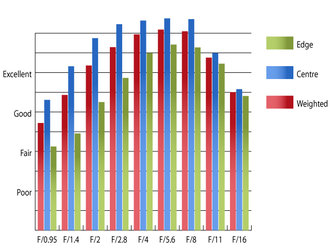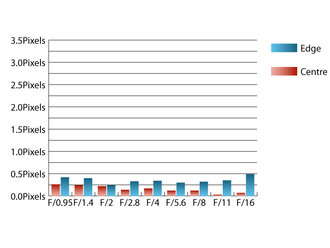Voigtlander 25mm f/0.95 Nokton Version II Lens Review
Voigtlander Nokton 25mm f/0.95 Version II Performance
At maximum aperture, sharpness in the centre approaches very good levels. As is common with fast aperture lenses like this, sharpness towards the edges of the frame lags behind somewhat at maximum aperture, only achieving fair levels on our scale. Even so, with care, this lens is very usable at maximum aperture, especially when using the central portion of the frame to isolate your subject from the background with shallow depth of field.Stopping down improves performance across the frame with excellent sharpness being achieved in the centre from f/1.4 and outstanding clarity from f/2 and beyond. Peak performance across the frame is achieved between f/4 and f/8. Here sharpness is outstanding across the frame.
 MTF | How to read our chartsThe blue column represents readings from the centre of the picture frame at the various apertures and the green is from the edges. Averaging them out gives the red weighted column.The scale on the left side is an indication of actual image resolution. The taller the column, the better the lens performance. Simple. For this review, the lens was tested on a Panasonic Lumix G6 using Imatest. |
Chromatic aberrations are very well controlled for a lens with such a fast maximum aperture with any fringing kept below half a pixel width, even at maximum aperture. This low level of fringing should pose no issues, even in images with high contrast towards the edges of the frame.
 CA | How to read our chartsChromatic aberration is the lens' inability to focus on the sensor or film all colours of visible light at the same point. Severe chromatic aberration gives a noticeable fringing or a halo effect around sharp edges within the picture. It can be cured in software.Apochromatic lenses have special lens elements (aspheric, extra-low dispersion etc) to minimize the problem, hence they usually cost more. For this review, the lens was tested on a Panasonic Lumix G6 using Imatest. |
Falloff of illumination towards the corners of the frame is pretty well controlled, given the extremely fast maximum aperture. At f/0.95 the corners are 2.18 stops darker than the centre of the frame and illumination is visually uniform with the aperture stopped down to f/2.8 and beyond.
Typically of lenses with a fast maximum aperture, slight barrel distortion is present. Imatest detected 2.9% barrelling, which is much stronger than you might expect from a prime lens and may be noticeable, especially with straight lines parallel to the edges of the frame or when shooting close up. The distortion pattern is uniform across the frame, so applying corrections in image editing software afterwards should be relatively straightforward.
Flare and loss of contrast when shooting into the light are rarely an issue with this lens, except when shooting into a very strong light source, such as the sun at wide apertures. The supplied hood does a pretty good job of shielding the front element from extraneous light that may cause issues. Contrast levels drop slightly at maximum aperture in all shooting conditions, which is fairly typical of very fast lenses.
Add your message
Login required
Please login here or if you've not registered, you can register here. Registering is safe, quick and free.
Please login here or if you've not registered, you can register here. Registering is safe, quick and free.
photodo Stats
1102 lenses
428 MTF tests
74 in-depth photodo reviews
100+ users join each day
Help the lens community by reviewing or rating a lens today via our lens search
428 MTF tests
74 in-depth photodo reviews
100+ users join each day
Help the lens community by reviewing or rating a lens today via our lens search
Latest Lens Reviews
- Chinon 28mm f/2.8 Vintage Lens Review
- Canon EF 70-200mm f/4L IS II USM Lens Review
- Samyang AF 85mm f/1.4 EF Review
- Sigma 70mm f/2.8 DG Macro Art Review
- Samyang AF 24mm f/2.8 FE Review
- Meike 50mm f/1.7 Review
- Tamron 70-210mm f/4 Di VC USD Review
- Lensbaby Burnside 35mm f/2.8 Review
- Asahi Super Takumar 50mm f/1.4 Review
- Asahi Super-Multi-Coated Takumar 135mm f/3.5 Review
